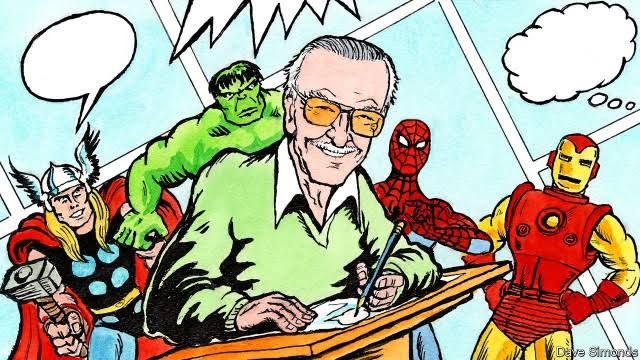
Perhaps he wasn’t born with superhero powers, like the X-Men — or the god Thor, for that matter. Perhaps he didn’t acquire them from a radioactive-spider bite (Spider-Man) or from studying the mystic arts (Doctor Strange). All the same, Stan Lee certainly had them! In his autobiography, graphic of course, they dazzled like sun-rays round his head. (He needed those tinted glasses he wore.) Waves of energy shook from his shoulders. For he was the man who had thought up those characters. He had brought Marvel Comics back from the dead, and with it the whole industry of comics, so that far from being something cheap and childish, which your parents didn’t want you to read, they became grown-up too! And wildly popular! And took over Hollywood, and with it the whole of American pop culture, earning revenues in the billions and billions of dollars! Phe-ee-ew.
But then his superheroes, and his supervillains too, had problems and lived in the real world, unlike the cut-out cardboard creatures that ruled the genre until he chanced along. In fact you might not notice they had powers at all. Like Reed Richards of the Fantastic Four, a nerdy scientist, who when pitted against Doctor Doom and his robot army could spool out into any length and shape! Or Peter Parker, just another adolescent worried about spots and girls, who when the Green Goblin loomed was suddenly Spidey, scaling skyscrapers and running across ceilings! Or Ben Grimm, a Jewish scrapper from Yancy Street who became the rocky orange bruiser known as the Thing, yelling “Clobberin’ time!”

So you would never have suspected anything of Stanley Leiber as he was growing up poor in Manhattan, with his father out of work, living on hot dogs and wandering the streets alone in summer while his friends were away at the camps his parents couldn’t afford. But he could feel that inner strength stirring! It came from words. He read and read and read. Adventure tales, Mark Twain, Jules Verne, Zola, Dickens, Shakespeare. He loved the sound of words, the music of vowels and consonants jostling each other. Inside him, he really believed, lay the Great American Novel!
Yet he stumbled into comic-book writing instead, at Timely Comics, Marvel as it became. And wallowed in embarrassment! People scorned him for his silly trade. On the literary totem pole in New York Stanley Lieber was the lowest of the low. Yet they did not know — even he did not know! — that as soon as he had signed himself “Stan Lee” on his first bit of text-filler in 1941, hiding himself as he thought, he was putting on his superhero clothes! Once the bright beams of his new ideas had dazzled his boss at Marvel (it took a while), nothing stopped him! Pulse-pounding characters flowed from him all the time. He could write five books a week. Sales of Marvel’s titles rose from 18.7m in 1961 to 32m in 1965 until dc Comics, and Superman and Batman, were stunned and reeling! Stan Lee’s legions of fans and true believers were exhorted to march onwards, shouting his watchword “Excelsior!” To the highest!
He revelled in his powers. These creations were not only living, breathing people, with the thought-balloons he had invented bubbling from their troubled heads. They also had their own words, their own melody, from the poetic turns of that sleek spacefarer, the Silver Surfer (“I, too, sense the icy touch of dread disaster!”) to the Shakespearean tones of Thor (“Whither goest thou?”) He resurrected Captain America, an old favourite, pulling him out of the Arctic ice cap to save the world again. He defied the massed sniffing prudes of the Comics Code Authority by writing about racism and drug abuse, until they capitulated! The X-Men, erupting in his brain in 1963, spoke for all outcasts, black, gay, disabled, who felt like mutants. But he challenged hippies and peace-marchers just as much by making them love Iron Man, a billionaire arms-maker, as a hero and not a villain! (That would have been too easy.) He had heroes who fought against themselves, like Dr Bruce Banner, who became that livid green monster, the Incredible Hulk! And tried to cure himself, but the Hulk didn’t agree! Right out of a Greek tragedy. Or maybe Freud.

Of course, there were trials to overcome. Two of the best artists, Jack Kirby (Fantastic Four, Silver Surfer) and Steve Ditko (Spiderman, Doctor Strange), felt uncredited and fell out with him. (Well, he was certainly grabbing most of the attention! And who said heroes always got on with one another?) Marvel’s fortunes fell in the 1980s and early 1990s, like those of comic books generally. His attempts to put his characters on tv mostly failed, because directors made them too one-dimensional. An internet company ended badly. It was Hollywood, and the Spider-Man and X-Men series in particular, that turned his luck right round again!
If there was a supervillain in his story, it was that other Green Goblin, dollar bills! Commercial worries often held back his ideas. He was careless with money, and Marvel gave him no royalties. He held no rights to his characters until, in 2001, he set up POW! (Purveyors Of Wonder!) Entertainment. Even so, he spent too much of his last years in lawsuits over percentages from tv and films. He wasn’t poor, of course! Just wanted his powers to be recognised.
No wonder he loved to take cameo parts in the hugely grossing films that featured his creations! While they fought to the death in the vicinity he played a FedEx delivery man, or a security guard, or a man watering his lawn, or a passenger reading “The Doors of Perception” on a city bus. He was the most ordinary person you could imagine! And yet, through his ideas, superheroically immortal.